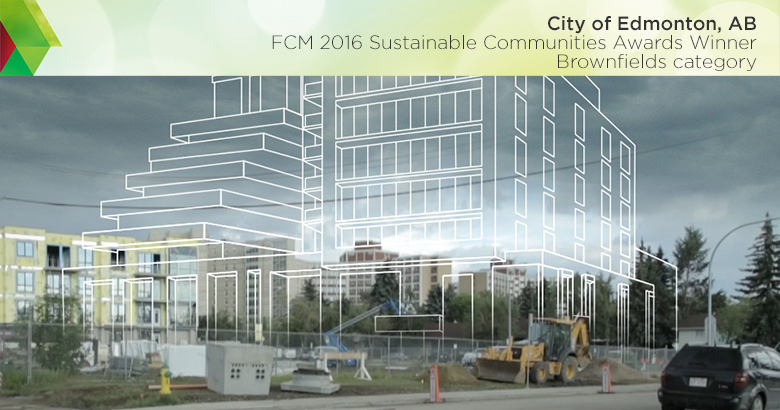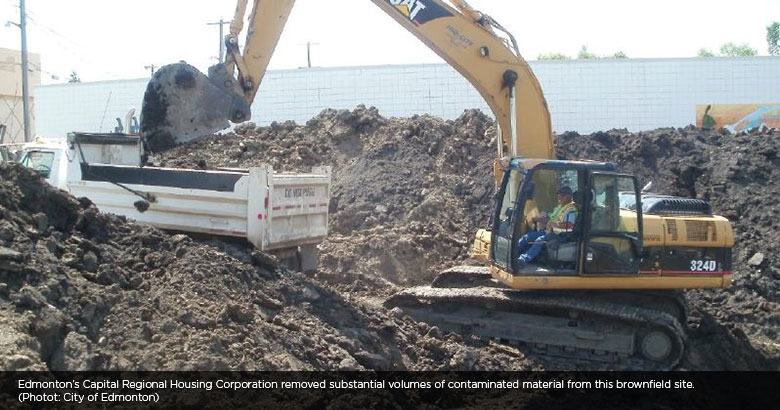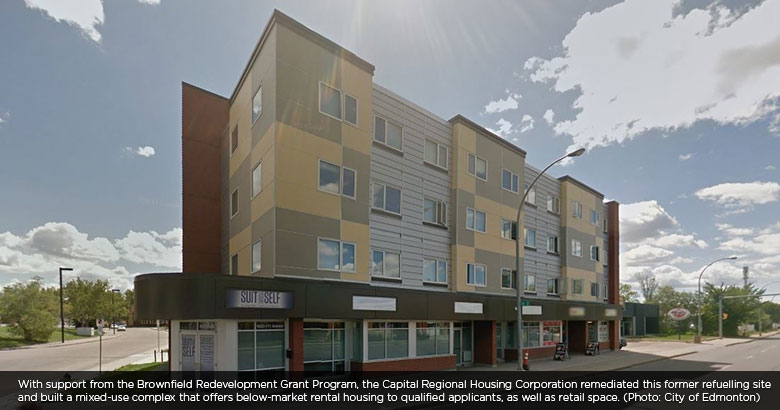Brownfields Redevelopment Grant Program revitalizes Edmonton neighbourhoods
The City of Edmonton's Brownfield Redevelopment Grant Program won an FCM Sustainable Communities Award for its strategies to clean up former refuelling sites and revitalize their community.
Read the case study below to learn more about program highlights, as well as the challenges and the lessons learned that can help your community in planning a similar initiative.

About the program
| Municipal population | Project duration | Total project value |
|---|---|---|
| 800,000 | April 2010–present | $5.8 million in funding committed to date (October 2015); $70,000 in start-up costs |
The City of Edmonton's Brownfield Redevelopment Grant program offers grants for all stages of brownfield remediation and includes environmental performance incentives. Initially developed with support from FCM's Green Municipal Fund, the program first targeted 50 contaminated gas stations and was later expanded to include all refuelling sites within the City of Edmonton. A task force of city councillors worked closely with a multidisciplinary staff team to create the program, which drew on extensive research into best practices in Canada and beyond, as well as consultation with local property owners, developers and industry experts. A municipal brownfield coordinator acts as a single point of contact for any brownfield-related inquiry.
The program provides financial support through four main phases of brownfield redevelopment:
- Phase 1: Historical Investigation — Phase I Environmental Site Assessment
- Phase 2: Testing, Delineation, Remedial/Exposure Control Planning — Phase II Environmental Site Assessment
- Phase 3: Site remediation
- Phase 4: Remediation/Exposure Control with an innovative interim land use solution
Phase 3 offers a grant for up to 100 per cent of remediation costs to qualifying applicants whose redevelopment plans meet Leadership in Energy and Environmental Design (LEED®) Silver standards. Grants for this phase are calculated based on anticipated increases in property tax revenue.
|


Project highlights
Results
| Environmental | Economic | Social |
|---|---|---|
|
|
|
Challenges
- Applicants often need assistance with calculating the value of potential grants vis-à-vis the anticipated remediation costs and projected increase in property value.
- Once sites with lower remediation costs were redeveloped, feedback indicated that the funding available for Phase 3 (remediation) no longer provided enough financial incentive. The city increased the amount of funding available for this part of the program, and added an innovative performance-based incentive.
- Challenges arise for projects that do not meet the requirements for 100 per cent funding under Phase 3 (remediation). If remediation costs are high, it may be difficult for the owner to recover the remaining costs, particularly in cases where zoning restricts the scope of redevelopment.
Lessons learned
- Plan to adjust and update the program once easier, more affordable projects have been completed and the "low-hanging fruit" disappears.
- Tie a performance standard (such as LEED® Silver or Gold) to grant eligibility.
- Research best practices from other jurisdictions (regardless of size) to understand what works.
- Promote the program through environmental consultants, construction firms and other professionals who benefit from brownfield redevelopment projects and are motivated to identify prospective applicants.
- Ensure that city councillors are familiar with the complexities of brownfield redevelopment, to help build their support for effective solutions.
- Establish a municipal brownfield coordinator as the single point of contact for owners and developers.
- Establish a multidisciplinary team of municipal staff to handle all matters related to contaminated properties.
More information
Barbara Daly, Brownfield Coordinator
City of Edmonton, Alberta
T. 780-944-0316
Want to explore all GMF-funded projects? Check out the Projects Database for a complete overview of funded projects and get inspired by municipalities of all sizes, across Canada.

